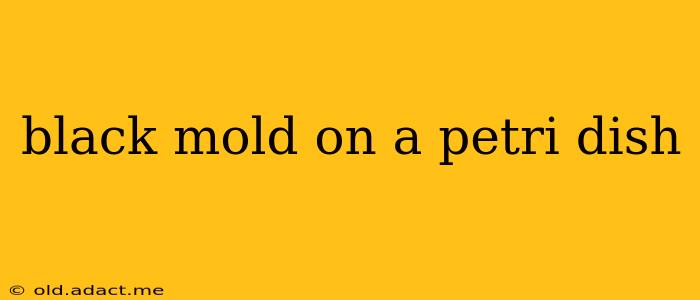Black mold on a petri dish is a common sight in microbiology labs, but its appearance can spark concern, especially for those unfamiliar with fungal growth. This comprehensive guide will delve into identifying black mold in a petri dish, understanding its growth conditions, and addressing the crucial safety precautions needed when handling it.
What Kind of Black Mold Could Be Growing?
Many different types of fungi can produce black spores or colonies on a petri dish. Pinpointing the exact species requires microscopic examination and potentially further testing. Common genera that might present as black mold include Aspergillus, Stachybotrys, and Cladosporium. These genera contain species with varying degrees of pathogenicity, meaning some are harmless while others can cause health problems, especially in immunocompromised individuals. It's crucial not to attempt identification based solely on visual observation.
How Does Black Mold Grow on a Petri Dish?
Black mold thrives in specific environmental conditions:
- Nutrient Source: Petri dishes typically contain a nutrient-rich agar, providing ample food for fungal growth.
- Moisture: Adequate moisture is essential for spore germination and mycelial (thread-like structures) expansion. A damp environment is ideal.
- Temperature: Most molds grow optimally at room temperature, though specific temperature ranges vary depending on the species.
- Oxygen: Like most aerobic organisms, black mold needs oxygen to grow.
What are the common sources of contamination in a petri dish?
Contamination leading to black mold growth can originate from several sources:
- Airborne Spores: Fungal spores are ubiquitous in the environment and readily settle on agar surfaces.
- Improper Sterilization: Inadequate sterilization of equipment, media, or the workspace itself introduces contaminating spores.
- Contaminated Samples: If the sample initially placed in the petri dish contains fungal spores, growth is inevitable.
Is Black Mold on a Petri Dish Dangerous?
The danger posed by black mold on a petri dish depends entirely on the specific species involved and the individual handling it. Some species are harmless, while others can produce mycotoxins (toxic compounds) or cause allergic reactions or infections. Never assume that black mold is safe to handle. Appropriate safety measures are always necessary.
How can I safely handle a petri dish with black mold?
Safe handling practices are paramount:
- Personal Protective Equipment (PPE): Always wear gloves, a lab coat, and eye protection when handling any petri dish with suspected mold growth. A respirator might be necessary depending on the potential for airborne spores and the individual's susceptibility.
- Proper Disposal: Dispose of contaminated petri dishes according to your institution's biosafety protocols. This typically involves autoclaving (high-pressure steam sterilization) to kill the mold before disposal.
- Avoid Inhalation: Minimize the potential for inhaling spores by working in a well-ventilated area or using a biosafety cabinet.
What should I do if I have black mold growing in my petri dish?
If you're conducting an experiment and black mold contaminates your petri dish, it indicates a flaw in your sterile technique. Review your sterilization methods, ensure proper aseptic techniques are followed, and consider repeating the experiment with meticulous attention to detail. If the mold is unexpected and in a non-laboratory setting, seek professional advice from a qualified mycologist or environmental specialist.
Can I identify the type of black mold just by looking at it?
No, visual identification alone is insufficient for accurate species determination. Black mold encompasses numerous species, many indistinguishable without microscopic examination and potentially advanced laboratory techniques.
This detailed information provides a comprehensive overview of black mold on a petri dish, offering insights into its growth, identification, and safety considerations. Remember, always prioritize safety and employ appropriate handling techniques when dealing with fungal cultures.
